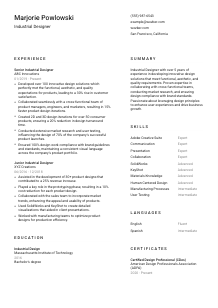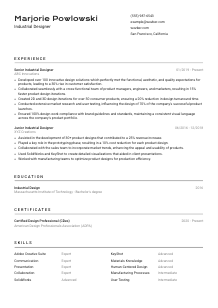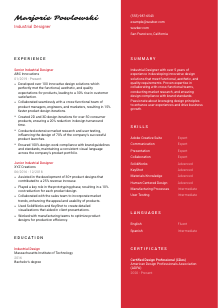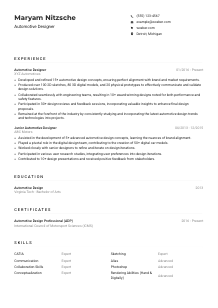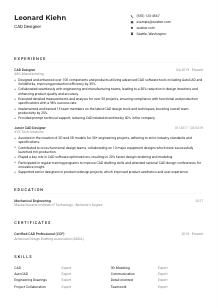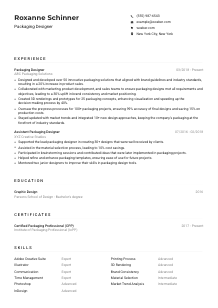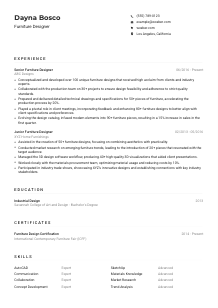Industrial Designer CV Example
Molding aesthetics, but finding your CV still in the prototype phase? Explore this Industrial Designer CV example, constructed with Wozber free CV builder. Grasp how you can seamlessly infuse your design prowess with job specifics, engineering a career as solid and functional as your creations!
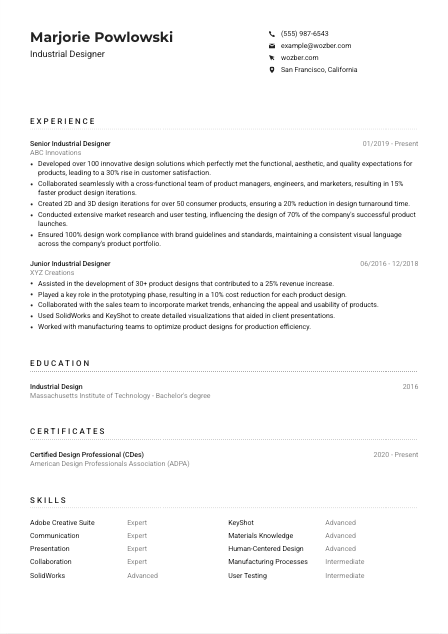
How to write an Industrial Designer CV?
Hello, aspiring Industrial Designer! The pathway to your dream role in the highly competitive design industry requires more than just a CV; it mandates a masterpiece that speaks volumes of your creativity, skill set, and design philosophy. By leveraging the prowess of Wozber's free CV builder, this guide is meticulously crafted to guide you in harmonizing your CV with the essential requirements of the Industrial Designer position you desire.
Ready to sculpt a CV that not only captures attention but also passes through the Applicant Tracking Systems (ATS) with finesse? Let's dive in and turn your aspirations into achievements!
Personal Details
The Personal Details section, though seemingly straightforward, is your first impression. Tailoring this to the Industrial Designer role ensures it's not just a header but a statement of intent, aligning perfectly with the job requirements.
1. Brand Yourself with Your Name
Your name is not just a label; it's the brand of your personal design philosophy. Make sure it's highlighted at the top, setting the tone for the unique design journey encapsulated in your CV.
2. Job Title Precision
Directly below your name, specify 'Industrial Designer,' mirroring the job title. This immediate alignment subtly influences the hiring manager's perception, affirming your fit for the role.
3. Essential Contact Info
Include your most accessible contact number and a professional email address. A format like firstname.lastname@domain.com reduces the chance of errors and maintains a professional tone.
4. Location Confirmation
Given that the role is location-specific, highlight "San Francisco, California" in your details. This aligns with the 'must be located in San Francisco, California' requirement, easing any potential concerns about relocation.
5. Professional Presence Online
If applicable, add a link to your LinkedIn profile or personal design portfolio website. Make sure it's current and showcases your projects, reflecting the depth of your design expertise and vision.
Takeaway
Your personal details are the blueprint to building a connection with potential employers. Craft this section with care, ensuring it's reflective of your professionalism and alignment with the Industrial Designer role. It's the initial brushstroke in the masterpiece of your career narrative.





Experience
The Experience section is the gallery of your professional journey. For an Industrial Designer, it's imperative to curate this gallery with projects and roles that mirror the requirements and expectations outlined in the job description.
- Developed over 100 innovative design solutions which perfectly met the functional, aesthetic, and quality expectations for products, leading to a 30% rise in customer satisfaction.
- Collaborated seamlessly with a cross‑functional team of product managers, engineers, and marketers, resulting in 15% faster product design iterations.
- Created 2D and 3D design iterations for over 50 consumer products, ensuring a 20% reduction in design turnaround time.
- Conducted extensive market research and user testing, influencing the design of 70% of the company's successful product launches.
- Ensured 100% design work compliance with brand guidelines and standards, maintaining a consistent visual language across the company's product portfolio.
- Assisted in the development of 30+ product designs that contributed to a 25% revenue increase.
- Played a key role in the prototyping phase, resulting in a 10% cost reduction for each product design.
- Collaborated with the sales team to incorporate market trends, enhancing the appeal and usability of products.
- Used SolidWorks and KeyShot to create detailed visualizations that aided in client presentations.
- Worked with manufacturing teams to optimise product designs for production efficiency.
1. Dissecting Job Requirements
Begin by deconstructing the job description. Highlight elements like 'developing innovative design solutions' and 'collaborating with cross‑functional teams,' which are pivotal in aligning your previous roles with the job at hand.
2. Chronology and Clarity
List your experiences in reverse chronological order, ensuring each role is clearly defined with your title, company, and the period you were employed there. This structure provides a clear, easily navigable professional timeline.
3. Crafting Compelling Narratives
For each role, articulate your responsibilities and achievements in a way that speaks to the criteria of the job description. Phrases like 'Developed over 100 innovative design solutions' directly echo the role's expectations, establishing your expertise.
4. Numbers Tell the Tale
Quantifying your achievements gives them weight. 'Leading to a 30% rise in customer satisfaction' quantifies your impact, making your contributions tangible and memorable.
5. Relevance Reigns Supreme
Prioritize experiences that showcase skills and achievements closely aligned with the Industrial Designer role. Extraneous details detract from the narrative; each bullet should be a brushstroke contributing to your professional portrait.
Takeaway
Imagine the Experience section as an exhibition of your professional journey, each role a masterpiece displaying your skills, creativity, and impact. Curate this gallery with care, making every bullet point a testament to your suitability and passion for the Industrial Designer role.
Education
The Education section lays the foundation of your design expertise. While it may seem straightforward, finessing this section to highlight its alignment with the Industrial Designer role's requirements can significantly enhance your CV.
1. The Keystone Requirement
Identify and highlight your Bachelor's degree in Industrial Design, directly addressing the 'Bachelor's degree in Industrial Design or a related field' requirement from the job description.
2. Form and Function
Keep this section tidy and functional: List your degree, the institution, and your graduation year. This clear, concise format allows the hiring manager to quickly verify your educational qualifications.
3. Degree Detailing
Ensure your degree title exactly matches the educational requirements of the job. This direct correlation reinforces your candidacy and speaks to your preparedness for the role.
4. Coursework Considerations
While not always necessary, if your academic journey included coursework particularly relevant to the demands of the Industrial Designer role, listing these can further underscore your specialized expertise.
5. Supplementary Scholarly Achievements
If applicable, mention honors, relevant extracurriculars, or projects that demonstrate your commitment to design beyond the classroom. This adds depth to your profile, especially for early-career professionals.
Takeaway
Your education section is an homage to your academic journey, reflecting the groundwork of knowledge that supports your design prowess. Craft this section to portray not just your qualifications, but your dedication and passion for Industrial Design.
Certificates
In the ever-evolving field of Industrial Design, certifications can set you apart, demonstrating your commitment to professional growth and mastery of specific skills. Let's illuminate how to spotlight this dedication in your CV.
1. Job Requirements Recap
First, review the job description. While it may not specifically require certifications, identifying those that align with the desired skills and responsibilities can significantly bolster your application.
2. Curated Certification Display
Quality overshadows quantity. Highlight certifications like 'Certified Design Professional (CDes)' that directly resonate with the professional standards and expectations of the Industrial Designer role.
3. Date and Relevance Acknowledgment
For certificates with expiration dates or those recently attained, include the dates to underscore your ongoing dedication to staying abreast of industry standards and techniques.
4. Continuous Learning
The field of Industrial Design is dynamic, with new technologies and methodologies constantly emerging. Show your commitment to continuous learning and skill enhancement through up-to-date certifications.
Takeaway
Your certifications are badges of honor, showcasing your dedication to excellence and continuous learning in the field of Industrial Design. Select and present them in a way that speaks volumes of your professional ethos and commitment.
Skills
The Skills section provides a concise overview of your professional arsenal. For an Industrial Designer, striking the balance between technical prowess and soft skills is essential. Let's craft a skills section that showcases your versatile toolkit in alignment with the job's demands.
1. Skills Deciphering
Begin by identifying both explicit and implicit skills required for the role. Skills like 'Adobe Creative Suite' and 'SolidWorks' are explicit, while 'effective communication' and 'collaboration' are implicit yet crucial.
2. Strategic Skill Selection
Zero in on skills from the job description that match your own and list them prominently. Combining technical skills with soft skills like 'Presentation' and 'Materials Knowledge' presents a well-rounded skillset.
3. Organized Presentation
While it might be tempting to list every skill you possess, focus on those most relevant to the Industrial Designer position. This targeted approach ensures that each skill listed directly contributes to portraying you as the ideal candidate.
Takeaway
Your skills section is a curated exhibition of your professional capabilities, presented in a way that immediately captures the essence of your suitability for the Industrial Designer role. Carefully selecting and listing your skills communicates not just proficiency but a strategic understanding of the role's demands.
Languages
In an increasingly global industry, linguistic skills can significantly enhance your appeal as a candidate. This section is about more than just listing languages; it's about strategically showcasing your global communication capabilities.
1. Language Requirement Review
Examining the job description reveals 'Fluent English is a requirement for this position.' This explicit need should be prominently addressed in your CV, positioning your linguistic abilities as a strong suit.
2. Primary Language Highlight
Starting with the essential language requirement, list English and your fluency level at the top, thereby directly addressing one of the key qualifications for the Industrial Designer role.
3. Additional Language Assets
Beyond the required language, listing additional languages you're proficient in can showcase your versatility and readiness to engage in diverse work environments or international projects.
4. Honesty in Proficiency
Clearly define your proficiency levels (e.g., fluent, intermediate) for each language listed. This transparency ensures clear communication of your capabilities and avoids any potential misunderstandings.
5. Reflection on Role Scope
Consider the broader context of the Industrial Designer role. If it includes international collaboration or multicultural team dynamics, your multilingual abilities become an even more significant asset.
Takeaway
Your ability to communicate in multiple languages is a reflection of your capacity to engage with diverse cultures and perspectives, a vital asset in the creative fields. List your linguistic skills with confidence, knowing they broaden the horizons of your professional and personal growth.
Summary
The Professional Summary is the centerpiece of your CV, offering a succinct overview of your career trajectory, skills, and potential contributions. It's your elevator pitch, distilled into a few compelling lines that resonate with the essence of the Industrial Designer role.
1. Essence Extraction
Start by absorbing the core demands and spirit of the job description. This deep understanding will serve as the foundation for crafting a summary that aligns with the expectations of hiring managers.
2. Opening with Impact
Introduce yourself with a statement that encapsulates your professional identity and biggest achievements. This sets the stage, inviting the hiring manager on a journey through your CV.
3. Reflecting Job Essentials
Weave in skills and accomplishments that echo the job's requirements, such as your '5 years of experience in developing innovative design solutions.' This targeted approach proves your alignment with the role.
4. Precision and Passion
Conclude your summary within 3-5 lines, striking a balance between offering a taste of your capabilities and leaving the reader eager to learn more. Be precise, passionate, and articulate your unique value proposition.
Takeaway
Your professional summary is the gateway to your CV, drawing the hiring manager into your narrative. Tailoring it to the job requirements transforms it into a compelling invitation, showcasing your potential to excel as an Industrial Designer. Craft this section with the care it deserves, and set the tone for the masterpiece that is your career.
Launching Your Industrial Designer Journey
Congratulations on completing your blueprint for an ATS-compliant, purposefully crafted Industrial Designer CV. With each section fine-tuned to echo the demands of your dream role, you're ready to capture the attention of hiring managers and bypass the ATS with ease. Let this CV be the key that unlocks the door to exciting new opportunities in the world of Industrial Design. Remember, your CV is a living document, a canvas for your professional achievements and aspirations.
Revise, refine, and keep your masterpiece current with Wozber's free CV builder, employing our ATS-friendly CV templates and ATS CV scanner for optimal performance. The world of Industrial Design awaits your unique vision and creativity. Step forth and make your mark!

- Bachelor's degree in Industrial Design or a related field.
- Minimum of 3 years of experience in designing consumer products or in a design consultancy setting.
- Proficiency in using design software such as Adobe Creative Suite, SolidWorks, and KeyShot.
- Strong understanding of materials, manufacturing processes, and human-centered design principles.
- Effective communication and presentation skills, with the ability to collaborate with cross-functional teams.
- Fluent English is a requirement for this position.
- Must be located in San Francisco, California.
- Develop innovative design solutions that meet the functional, aesthetic, and quality requirements of products.
- Collaborate with product managers, engineers, and marketers to create and refine product designs based on feedback and research.
- Create detailed 2D and 3D design iterations and provide design documentation for manufacturing.
- Conduct market research, user testing, and competitor analysis to inform design decisions.
- Ensure all design work aligns with brand guidelines and standards, maintaining a consistent visual language across products.





